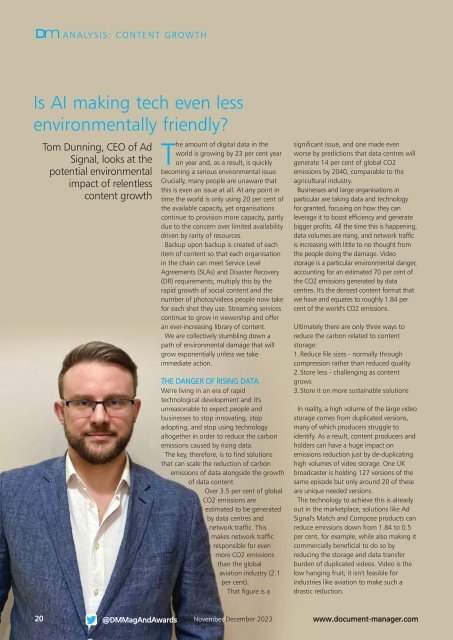You also want an ePaper? Increase the reach of your titles
YUMPU automatically turns print PDFs into web optimized ePapers that Google loves.
Dm ANALYSIS: CONTENT GROWTH<br />
Is AI making tech even less<br />
environmentally friendly?<br />
Tom Dunning, CEO of Ad<br />
Signal, looks at the<br />
potential environmental<br />
impact of relentless<br />
content growth<br />
The amount of digital data in the<br />
world is growing by 23 per cent year<br />
on year and, as a result, is quickly<br />
becoming a serious environmental issue.<br />
Crucially, many people are unaware that<br />
this is even an issue at all. At any point in<br />
time the world is only using 20 per cent of<br />
the available capacity, yet organisations<br />
continue to provision more capacity, partly<br />
due to the concern over limited availability<br />
driven by rarity of resources.<br />
Backup upon backup is created of each<br />
item of content so that each organisation<br />
in the chain can meet Service Level<br />
Agreements (SLAs) and Disaster Recovery<br />
(DR) requirements; multiply this by the<br />
rapid growth of social content and the<br />
number of photos/videos people now take<br />
for each shot they use. Streaming services<br />
continue to grow in viewership and offer<br />
an ever-increasing library of content.<br />
We are collectively stumbling down a<br />
path of environmental damage that will<br />
grow exponentially unless we take<br />
immediate action.<br />
THE DANGER OF RISING DATA<br />
We're living in an era of rapid<br />
technological development and it's<br />
unreasonable to expect people and<br />
businesses to stop innovating, stop<br />
adopting, and stop using technology<br />
altogether in order to reduce the carbon<br />
emissions caused by rising data.<br />
The key, therefore, is to find solutions<br />
that can scale the reduction of carbon<br />
emissions of data alongside the growth<br />
of data content.<br />
Over 3.5 per cent of global<br />
CO2 emissions are<br />
estimated to be generated<br />
by data centres and<br />
network traffic. This<br />
makes network traffic<br />
responsible for even<br />
more CO2 emissions<br />
than the global<br />
aviation industry (2.1<br />
per cent).<br />
That figure is a<br />
significant issue, and one made even<br />
worse by predictions that data centres will<br />
generate 14 per cent of global CO2<br />
emissions by 2040, comparable to the<br />
agricultural industry.<br />
Businesses and large organisations in<br />
particular are taking data and technology<br />
for granted, focusing on how they can<br />
leverage it to boost efficiency and generate<br />
bigger profits. All the time this is happening,<br />
data volumes are rising, and network traffic<br />
is increasing with little to no thought from<br />
the people doing the damage. Video<br />
storage is a particular environmental danger,<br />
accounting for an estimated 70 per cent of<br />
the CO2 emissions generated by data<br />
centres. It's the densest content format that<br />
we have and equates to roughly 1.84 per<br />
cent of the world's CO2 emissions.<br />
Ultimately there are only three ways to<br />
reduce the carbon related to content<br />
storage:<br />
1.Reduce file sizes - normally through<br />
compression rather than reduced quality<br />
2.Store less - challenging as content<br />
grows<br />
3.Store it on more sustainable solutions<br />
In reality, a high volume of the large video<br />
storage comes from duplicated versions,<br />
many of which producers struggle to<br />
identify. As a result, content producers and<br />
holders can have a huge impact on<br />
emissions reduction just by de-duplicating<br />
high volumes of video storage. One UK<br />
broadcaster is holding 127 versions of the<br />
same episode but only around 20 of these<br />
are unique needed versions.<br />
The technology to achieve this is already<br />
out in the marketplace, solutions like Ad<br />
Signal's Match and Compose products can<br />
reduce emissions down from 1.84 to 0.5<br />
per cent, for example, while also making it<br />
commercially beneficial to do so by<br />
reducing the storage and data transfer<br />
burden of duplicated videos. Video is the<br />
low hanging fruit; it isn't feasible for<br />
industries like aviation to make such a<br />
drastic reduction.<br />
20<br />
@<strong>DM</strong>MagAndAwards<br />
<strong>Nov</strong>ember/<strong>Dec</strong>ember <strong>2023</strong><br />
www.document-manager.com
















